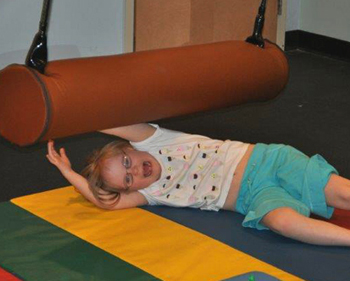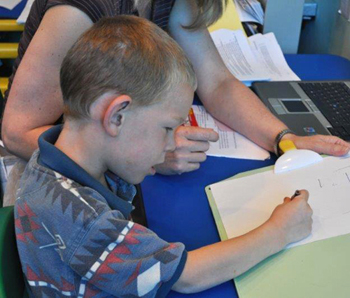
|
Pediatric Occupational, Physical, ABA/Behavioral, Feeding, Speech, and Language Therapies Main Clinic: 931-372-2567 1445 East 10th Street Cookeville, TN 38501 Email: [email protected] HIPAA Secure Email: [email protected] Fax: (931) 372-2572 ABA Clinic: 931-201-9534 400 Dubois Road Cookeville, TN 38501 Email: [email protected] Please call today to get started! Most insurances accepted! |

|
| Who needs therapy? | SE HABLA ESPAÑOL |
Learning Environment Modifications

-
Start the day at home with calming sensory input and movement- ask your OT for what is best for your child.
-
Use a picture schedule for the day's events and review this at breakfast, in the car, and teacher reviews events of day at school. When an activity is completed, then the picture goes in the all done envelope. Using do THIS- THEN reward schedules can help with transitions.
-
Make sure there are sensory diet breaks at least every hour, with short intense learning periods mixed in with movement and sensory diet activities.
-
ROUTINE, ORGANIZATION, AND PREDICTABILITY are vital to their ability to focus and attend! Anything that is unpredictable, chaotic, unorganized, or cluttered makes them feel very unfocused and they cant attend to what is important.
-
Use regular sensory breaks using the above suggestions and Tool Chest handouts. Visual distractions are very hard for them to "filter" and get used too, this only takes away from them looking at you the teacher! The colors blue and green are great calming colors and are best if walls are left with nothing on them.
-
Cut down on auditory and visual distractions. Cover up bookshelves and all extraneous stuff in room with calming green or blue sheets, make an office cubicle that is blank on the inside (they can decorate their "office" on the outside) with 3 fold presentation folders.
-
Allow for standing times at a desk, or laying on belly on the floor, or sitting on a therapy ball when trying to listen or recite or answer questions. Get up and have structured movement times very often!
-
Look at Montessori teaching techniques and other hands on learning books for ideas! Think of how you learn the best, through doing, touch and movement!
-
Use a Red Time Timer- on amazon.com when they must sit for certain period of time, and tell them that they cannot get out of their seat until timer goes off, and when the timer goes off then they can choose a sensory diet activity. This helps the student know when the work will end, and a sensory motor break is coming.
-
Use a green box for items "to do", and red all done on the right. Allow them to pick the order they do the items to have some free will.
-
After an unorganized and unstructured time such as cafeteria or recess, or a classroom visitor popping in, do a classroom calming activity such as Soldier Walks to a metronome beat: Russian soldiers with same arm and leg up and down, then British soldier with opposite arm and leg, clap patterns to a beat, Brain Breaks, Go Noodle, etc to get them listening and calm again after an unorganized activity.
-
Tree waving: Have class march around the room following a path that is marked clearly on the floor (can also use path to follow for creeping activities) with no obstructions in the way and have students pretend to be trees waving in the breeze, "how slowly can you wave?", you can do this standing behind chairs as well if the marching is too distracting and unorganized.
-
Often the cafeteria is too much for these students and they feel out of control and disorganized. May want to look at creating a "quiet lunch group" picking a small group that eats separately and play soft relaxing music.
-
Have a calming area in the classroom or a sensory area at home. This is an area that the child can go to when they are feeling overly stressed, and can swing calmly, rock in a glider or chair, sit on a bean bag and look at books, lay a bean bag on their body, go into a small tent, vibration massage pad on a bean bag or cover a table with a dark cloth and let child go under there to calm down. This area has to be used wisely and cannot continue to be a way out of work. Use headphones with Gregorian chant or other calming music such as light classical music in this area as well, or play for the entire classroom.
-
Some need "white noise" to help filter background noises this is often a fan or a CD made especially for white noise or calming music choices.
-
Use a reward system that is easily achieved such as the sensory diet choice, tokens, or sticker sheet, with a larger reward at the end of the day or week when goals are achieved. This often has to be changed as they may get bored with the rewards pretty quickly. These children need as much positive feedback and encouragement as possible, they already feel like a failure and self esteem is always an issue, avoid as much failures as possible, look for the good in everything!
-
Give each child a sign like a red card, or "Break PLEASE" or some kind of sign language that can be shown and raised to your attention when they feel like they are losing control. Give an immediate calming tool break or fidget basket, or walk in the hallway. This prevents explosions and outbursts!
-
Sit on the left of the student and present activities one at a time and use a green box for "go" to have items to work on and the red on the right for "all done" and work from left to right in presentation. This helps with the left to right movement necessary for hands and eyes when writing and reading.
-
for those fidgety in the seat, use a Move and sit seat insert, battery operated neck or lower back massager in the chair, weighted vest, therapy ball chair, or other adaptions to help get the wiggles out.
All children need routines, and schedules that the student can understand help to establish predictability and routines which help the child tremendously...
1. Start each morning with an outline of the schedule for the day, highlight any changes that may be different. For younger children, you will have to keep it simple with shorter lengths of time, such as for the morning schedule before lunch, then review the afternoon after lunch. Use large picture symbols, and PECS system and place it where it can be seen such as on the desk, or on the board so that it can be found easily. Take off symbols and put in an all done basket when that task is accomplished to help the child keep track of what is next.
2. Use timers, such as the Red timers or digital timers that the child can understand for each activity length. This helps the child know when a sensory motor break is coming, hopefully a small break in between each 30 minute schedule, then larger 20 minute breaks after each 2 hour block.
3. Discuss or create stories about unexpected events such as fire drills to prevent meltdowns when they occur, take children to the gym or cafeteria before everyone arrives or a big event, or tape record these more stressful times and play in preparation for the actual event.
4. Use adaptions for each transition, such as the working left to right and all done basket routine; the clean up song, or other ways to cue the child that it is time to transition. Giving two choices with symbols helps with transitions as well.
5. Assist older children with homework organization, write it down in a specific place in their binders, or tape record assignments.
6. Color code notebooks and book covers to go together, or dividers in one large notebook to match so that they can keep track of each class.
7. Create classroom schedule with many breaks for movement and sensory motor activities. A good schedule goes as follows:
*Start the day with movement: Swinging, jumping to letters or spelling words, bdpq code charts, soldier walks, Simon Says, etc.
If you can start your day with gym or recess with structured play, this is best. Try to encourage linear calming swinging, limit erratic movements and unorganized play.
* Give small sensory motor breaks after each task or 30 minute class, such as Animal walks, chair push ups, wheelbarrow walk, jumping, weighted ball, therapy ball activities, calisthenics, carrying or pushing heavy objects...
* Give a larger and longer (at least 20 min.) sensory motor break every two hour (gym, recess, any movement works well in tight schedules) making sure that the child receives vestibular (swinging best) and proprioceptive (joint & muscle heavy work).
Site empowered by
WebOnTheFly